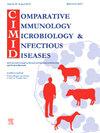亚洲次区域野生鸟类和家禽高致病性H5N1和H5Nx禽流感的多变量分析
IF 2
3区 农林科学
Q4 IMMUNOLOGY
Comparative Immunology Microbiology and Infectious Diseases
Pub Date : 2025-08-05
DOI:10.1016/j.cimid.2025.102387
引用次数: 0
摘要
高致病性禽流感(HPAI)病毒在全世界野生鸟类、家禽和其他牲畜中的传播引起了极大关注,特别是在许多野生鸟类的迁徙路线与家禽养殖场相交的亚洲。这经常导致野生鸟类和家禽在季节性迁徙期间相互作用。这些相互作用影响禽流感亚分支和血清型在亚洲流行的国家的出现和再出现。利用粮农组织(FAO)的疫情数据,我们研究了2004年1月至2024年8月期间亚洲野生鸟类和家禽中HPAI H5确诊病例的地理分布。H5N1是报告的所有HPAI H5血清型中最普遍的血清型,其次是H5N8。时间分析显示,亚洲地区爆发了三波疫情:2004-2005年的最初高峰,2009-2011年左右的第二波,以及最近的2017年至2023年的第三波。采用多变量泊松回归模型评估不同类别鸟类中HPAI H5确诊病例的地理、季节和年分布规律。结果表明,这些因素显著影响高致病性禽流感H5的流行,与野生鸟类相比,东南亚的H5N1和东亚的H5N8风险更高,特别是在冬季和家禽中。我们的研究结果强调需要有针对性的监测、基于风险的管理和协调的干预措施,以减轻高致病性禽流感H5在高风险地区的传播。该研究提供了有价值的见解,可用于改进生物安全措施,并为有效控制和预防亚洲高致病性禽流感疫情的政策提供信息。本文章由计算机程序翻译,如有差异,请以英文原文为准。
Multivariable analysis of highly pathogenic H5N1 and H5Nx avian influenza in wild birds and poultry in Asian subregions
The spread of highly pathogenic avian influenza (HPAI) virus in wild birds, poultry, and other livestock worldwide has caused great concerns, especially in Asia, where the migration routes of many wild birds intersect with poultry farms. This often leads to interactions between wild and domestic birds during seasonal migration. These interactions influence the emergence and re-emergence of subclades and serotypes of avian influenza in Asia countries that are endemic to the disease. Using outbreak data from the Food and Agriculture Organization (FAO), we examine the geographical distribution of confirmed HPAI H5 cases in wild birds and poultry across Asia between January 2004 and August 2024. H5N1 is the most prevalent serotype among all HPAI H5 serotypes reported, followed by H5N8. The temporal analysis reveals three waves of outbreaks across Asian regions: an initial peak in 2004–2005, a second wave around 2009–2011, and a third, more recent wave, from 2017 to 2023. Multivariable Poisson regression models were used to assess the geographical, seasonal and yearly patterns of confirmed HPAI H5 cases among different categories of birds. The results indicate that these factors significantly influence the prevalence of HPAI H5, with a higher risk of H5N1 in Southeast Asia and H5N8 in East Asia, particularly during the winter and in poultry, as compared to wild birds. Our findings highlight the need for targeted surveillance, risk-based management, and coordinated interventions to mitigate the spread of HPAI H5 in high-risk areas. This study provides valuable insights that could be used to improve biosecurity measures and inform policies for the effective control and prevention of HPAI outbreaks in Asia.
求助全文
通过发布文献求助,成功后即可免费获取论文全文。
去求助
来源期刊
CiteScore
4.60
自引率
0.00%
发文量
102
审稿时长
40 days
期刊介绍:
Comparative Immunology, Microbiology & Infectious Diseases aims to respond to the concept of "One Medicine" and to provide a venue for scientific exchange. Based on the concept of "Comparative Medicine" interdisciplinary cooperation between specialists in human and animal medicine is of mutual interest and benefit. Therefore, there is need to combine the respective interest of physicians, veterinarians and other health professionals for comparative studies relevant to either human or animal medicine .
The journal is open to subjects of common interest related to the immunology, immunopathology, microbiology, parasitology and epidemiology of human and animal infectious diseases, especially zoonotic infections, and animal models of human infectious diseases. The role of environmental factors in disease emergence is emphasized. CIMID is mainly focusing on applied veterinary and human medicine rather than on fundamental experimental research.

 求助内容:
求助内容: 应助结果提醒方式:
应助结果提醒方式:


